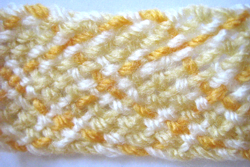On the photo you see my try of the technique described in the tutorial on how to braid a scarf.
I used simple acrylic yarn and it looks as if I pulled more on one side then on the other, as you can see on the photo.
At a later moment I will try it again, because I like how it should look ;-)
Category: Yarn
Freeform Embroidery
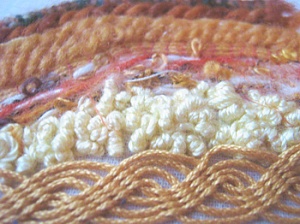
On the photo you see my idea of Freeform Embroidery which was highly inspired by ‘Rock Pool’ and ‘Laying It On The Line’.
I used a piece of old (but clean! ;-)) bedsheet as base. First I laid some worsted and funky yarns on it which I fixed with couching stitches (at the top of the photo). Then I stitched some french knots (light yellow on the photo). Below is my first attempt at ply-split braiding which I fixed with some couching stitches too.
It is one of my many UFOs (‘unfinished objects’), but one day I will come back to it ;-)
Links:
Inspirations: ‘Rock Pool’ / ‘Laying It On The Line’
English Embroidery Stitch Diagrams
Deutsche Stickstichbeschreibungen
Couching stitches (English)
Couching stitches (German)
French knots (English)
French knots (German)
Ply-split Braiding: a (very) short description and resources
PDF Ply-split tutorials by Peter Collingwood (scroll down)
Friendship Bracelet
I once braid a Friendship Bracelet, but in just one colour. The ones at Heather’s Friendship Bracelets are so beautiful because of the different colour patterns she presents.
I haven’t done them yet, but they are on my to-do list (together with a gazillion of other things to try ;-))
Links:
Heather’s Friendship Bracelets
Note: even though there’s written something about a move I could stilll reach the links
Friendship Bracelet – first pattern of first set
Clothesline Crochet
I mentioned the clothesline crochet before when I described the Simple Cro-Tat.
But because I find clothesline crochet a handy technique when I want to work something stiff (for a little bowl e.g.) I wanted to present the tutorial on how to make clothesline crochet in the round with its own entry (tutorial see links below).
Priscilla Hewitt has also other clothesline crochet tutorials and tipps about what yarns and what clothesline to use (see links below).
On the photo you see my attempt on crocheting such a little bowl.
I used quite a thick string and crocheted with crochet cotton, which is rather thin.
Because I’m always working very loosely, I could never have created a bowl with this yarn.
The clothesline crochet technique made it possible.
Links:
Tutorial on how to make clothesline crochet in the round
Other clothesline crochet tutorials and tipps
Addendum of February 2009: The links above don’t work anymore, you can find the instructions for the clothesline crochet now as PDF (about 540 KB) at Priscilla’s Crochet – Free Pattern Index, check there for ‘Clothesline Crochet’.
Here at unikatissima:
Simple Cro-Tat
Paper Crazy Quilt
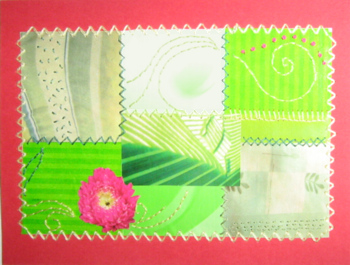
I love Crazy Quilts, because it is a kind of Freeform work, but I don’t like sewing. So I began to make my quilts on and with paper.
On the photo you see a card I made with this technique.
I didn’t only embroider the seams but I also used some fancy stitches like French Knots e.g. (the red dots on the photo) onto the surfaces.
To make your own Paper Crazy Quilt, find matching papers and cut them into pieces. On the photo I used rectangles, but the typical Crazy Quilt distribution is also beautiful (here you can find some lovely blocks here you can find some lovely blocks).
Glue the collage on thin paper and then begin embroidering (carefully!) as if it was a real Crazy Quilt (here is an online class for Crazy Quilts).
To finish you glue or embroider your Paper Crazy Quilt on cardboard.
Links:
Crazy Quilt blocks
Tutorial moved to: Crazy Quilt blocks
English Embroidery Stitch Diagrams
Deutsche Stickstichbeschreibungen
French knots (Knötchenstiche) (English)
French knots (Knötchenstiche) (German)
Stitched Flowers
While I was browsing through the projects of STITCH I found Precious Petals. They ‘glue’ the flowers on fabric and then embellish with decorative stitching.
A stunning idea which is still on my to-so list.
Links:
STITCH project: wonderful projects around stitching (how surprising ;-))
Simple Cro-Tat
There is a technique called Cro-Tat, which is a technique between Crochet and Tatting: the item it is crocheted, but looks like tatted. For tutorials look beneath the Links.
I don’t have a straight steel crochet hook and so I figured out how to do this in another way.
It is a kind of clothesline crochet: I am crocheting a simple chain that I ‘decorate’ with single crochets.
I once wrote a (German) tutorial on how to make a Mother’s Day card with a Simple Cro-Tat Ornament. It is heavily illustrated ;-)
Anyhow: ‘Luftmasche’ is chain, ‘feste Masche’ is single crochet and ‘Kettmasche’ is slip stitch, the actual row is red, the previously worked rows are in black.
Links:
Tutorial on how to make a Mother’s Day card with a Simple Cro-Tat Ornament (German)
Tutorial on how to make another Simple Cro-Tat Ornament (German) (‘Zusammen häkeln’ means join)
Cro-Tat
Cro-Tat Instructions (English) The link isn’t available no more. Try instead to find an appropriate tutorial in this list of Cro-Tat Instructions.
Cro-Tat Instructions (German)
Here at unikatissima: Clothesline Crochet
Coloured Yarns
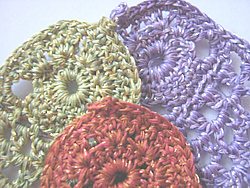
I like to work little pieces where not much yarn is required and I like to use a different colour and colour shade with each piece.
Unfortunately I can’t afford to always buy the shades I like: on the one hand it is too expensive and on the other hand I don’t have enough place for such a big stash.
Therefore I like to work with four to six sewing yarns in similar shades and – if I am in the mood – one or two metallic sewing yarns. They don’t take so much place and I can get much more subtle shades by combining them then I ever could buy.
I put the chosen yarn in a dessert bowl, so that they don’t roll away and begin crocheting.
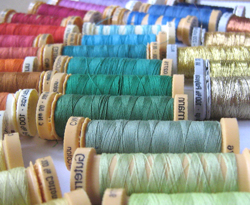 I worked the Crochet Chamsas I presented yesterday with this ‘technique’.
I worked the Crochet Chamsas I presented yesterday with this ‘technique’.
Links:
Here at unikatissima:
Crochet Chamsa
Starburst Card
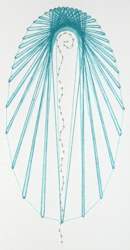
I love many of the string art patterns, but I would never make them, because I find them on the other side quite old fashioned.
Although the I thought that I could use the pattern to create a card.
I pricked the holes of the Starburst pattern Starburst pattern (template here template here) from The Art of Thread Design The Art of Thread Design into my cardboard and measured the length of thread. About 8m (about 26 feet ;-)). Then I started to weave the thread through the holes. I hadn’t finished the first two stitches when my thread became a firm knot. Totally entangled. Absolutely un-detangable.
Therefore I had to try something else with new thread.
I thought (what I should have done beforehand ;-)) that in string art they use pegs (nails) to fix the thread at the predefined points. Then I realised that I could have a kind of pegs too: if I weave the thread over and under the holes (from hole 1 to hole 2, 2 to 3, 3 to 4 etc) and back, I get a coloured frame where the holes are, I get pegs, because one thread goes from the front side to the back side and vice verso (see picture).
Now I could wrap the thread around my self-made pegs just in the same way they are doing it in string art around the nails.
I enjoyed working on the Starburst pattern, but at one end it is very narrow and I only could use two layers in place of three.
Links:
The Art of Thread Design
Starburst pattern instructions
Starburst pattern template
The original site doesn’t exist any more and is now available through webarchive:
The Art of Thread Design
Embroidery Crust
The title is far from perfect ;-)
Better look at the original instruction on how to encrust calico with embroidery.
On the photo you see my first (and only) attempt at doing it, but I didn’t get far with it and created (another! ;-)) UFO (unfinished object).
But the real thing is soo beautiful!
Links:
Stitch with the Embroiderers’ Guild – A magazine for creative stitchers
Online projects from the Embroiderers’ Guild
